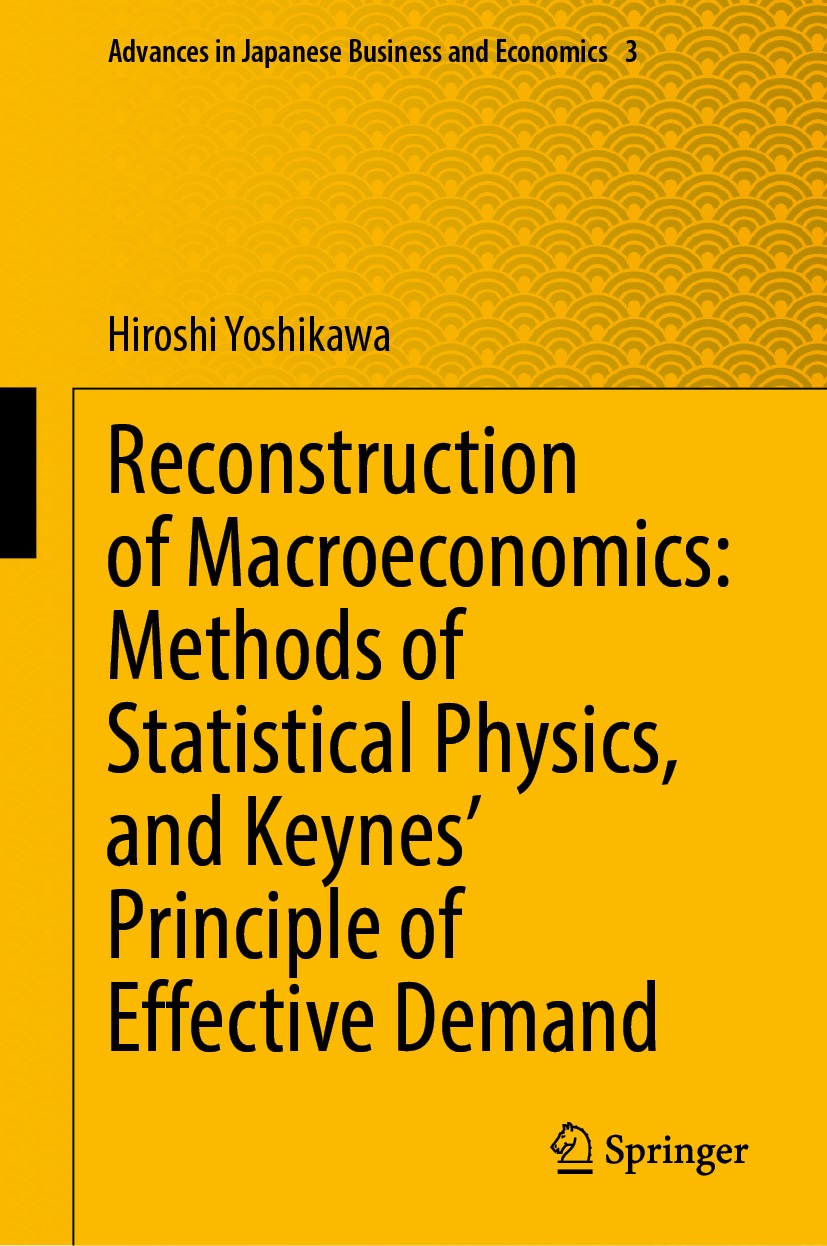
書籍名
Reconstruction of Macroeconomics: Methods of Statistical Physics, and Keynes’ Principle of Effective Demand
判型など
238ページ、ハードカバー
言語
英語
発行年月日
2022年10月30日
ISBN コード
978-981-19-5263-0
出版社
Springer
出版社URL
学内図書館貸出状況(OPAC)
英語版ページ指定
今日われわれが「マクロ経済学」とよぶ学問が確立していく過程で最大の課題となったのは景気循環、とりわけ深刻な不況、失業をいかに説明するか、ということだった。そうした中で最終的に「正解」を得たのが、1936年に刊行されたケインズの『一般理論』だったのである。
ケインズによれば、不況すなわちGDPの落ちこみは総需要の低下によって起きる。逆に好況は需要の盛り上がりによって生じる。私がこの「有効需要の原理」を「正解」とよぶ理由は、どこの国でも、いつの時代も、この「原理」が成り立たなかったことは一度として無いからである。だからこそ、今日でもGDPの四半期ごとの速報値が公表されるときには、内閣府は需要項目別の成長率寄与度を明らかにし、新聞もまたそれを重要な情報として伝えるのである。
総需要がなぜアップダウンするのか、その理由は国により、時代により千差万別である。輸出の増減、技術革新による投資ブーム、金融危機による投資の落ちこみ、政府の支出増大等々有効需要が変動する理由はさまざまだが、とにかく需要の変動が景気循環を説明する。このことに例外はない。戦後ケインズ経済学がマクロ経済学の基本的なフレームワークとして広く受け入れられた理由も、ここにあるといえるだろう。
これに対して1960年代末から始まったマクロ経済学の変容、すなわち「ケインズ反革命」は、経済学という学問の世界の中でのある意味でぺダンティック、分かりやすくいえば「頭でっかち」な論争から始まった。具体的には、ケインズ経済学が、新古典派理論の立場から見たときに、しっかりとした「ミクロ的基礎づけを持たない」という批判である。過去50年間のマクロ経済学の変遷を振り返ると、それはイデオロギー論争としての側面も持っていた。政府の政策的介入を積極的に求めるケインズ経済学に対して、それを嫌う新古典派経済学の逆襲である。中心的な役割を担ったのは、米国のシカゴ大学を中心とする「シカゴ学派」、すなわちミルトン・フリードマンたちである。
残念ながら過去50年間、マクロ経済学は、複雑な数式に囲まれた見た目上のソフィスティケーションとは裏腹に、1国経済の動きを説明するという本来の役割をまったく果たせなくなってしまった。2008年9月、米国の証券会社リーマン・ブラザーズの破綻を機に生じた世界同時不況で危機に直面した各国政府はケインズ的な財政政策に訴え、それが1930年代に起きたような「大不況」に世界が陥ることを未然に防いだ。それは現実の経済にとってよかったが、問題は、こうした政策が過去50年間のマクロ経済学とはまったく接点をもたないものだったことである。
マクロ経済学の「混迷」を救うには何が必要か。第一は、「混迷」がいかなる意味での混迷なのかを明らかにすることである。その上で、混迷から抜け出る道を示した2人の天才経済学者、ケインズとシュンペーターの遺産を生かすことだ。本書では、このことを詳しく説明している。
(紹介文執筆者: 経済学研究科・経済学部 名誉教授 吉川 洋 / 2024)
本の目次
1.1 Beginnings
1.2 Representative Consumer/Firm
1.3 Lucas Model—An Example
1.4 Economic Agent Optimization
1.5 Rational Expectations
1.6 Walras’ General Equilibrium Theory
2 Statistical Physics and Macroeconomics
2.1 Variational Principle—Is an Inorganic Particle Fundamentally Different from Us?
2.2 The Method for Macro Analysis
2.3 Ramsey Model
2.4 Markov Model of the Business Cycle—An Example
3 Stochastic Macroequilibrium: A Microfoundation for Keynesian Economics
3.1 Introduction
3.2 Limitations of Search Theory
3.3 Distribution of Productivity as a Measure of Underemployment
3.4 Stochastic Macroequilibrium—The Basic Idea
3.5 The Model
3.6 The Principle of Effective Demand
4 Business Cycle: The Role of Aggregate Demand
4.1 Introduction
4.2 Analysis Based on Industry Data
4.3 Concluding Remarks
5 Demand Saturation and Economic Growth—Where Keynes and Schumpeter Meet
5.1 Growth Theory
5.2 Lewis Model
5.3 Saturation of Demand
5.4 Product Innovations and Economic Growth
5.5 Population and Economic Growth
6 Prices, Wages, and Monetary Policy
6.1 Deflation and the Economy
6.2 Monetary Policy and Expectations
6.3 Determination of Price
6.4 Individual Prices and Aggregate Price Index
6.5 Wages
6.6 Summary
7 Financial Markets and the Real Economy
7.1 The Neoclassical Approach
7.2 Mathematics of Asset Price Fluctuations
7.3 The Bubble
7.4 Difference Between Financial Markets and the Real Economy
7.5 Rationality in Financial Markets
8 Summing Up
Appendix: Pioneers
References
Index
関連情報
“It (Chap. 3) captures analytically a good part of the intuition that underlies the Keynesian economics of people like Tobin and me.”
—Robert Solow, Emeritus Institute Professor of Economics, Massachusetts
Institute of Technology, Nobel Laureate in Economics, 1987
Professor Hiroshi Yoshikawa provides a unique synthesis of statistical physics and macro-economic theory in order to confront the dismal failure in economics and in finance to understand how an economy or a financial market works, given the heterogeneous decision making of many different individual interacting actors. Economics has failed in this regard with the naive and often misleading concept of “representative agents”. The author presents many insights on the historical development, concepts, and errors made by the most illustrious economists in the past. This book should be essential readings for any economics students as well as academic researchers and policy makers, who should learn to bring back good-sense thinking in their impactful decisions.
—Didier Sornette, Professor on the Chair of Entrepreneurial Risks at the Swiss
Federal Institute of Technology Zurich (ETH Zurich)
日本語版:
吉川 洋 著『マクロ経済学の再構築 - ケインズとシュンペーター』(岩波書店、2020年) – 品切れ
https://www.iwanami.co.jp/book/b521342.html
日本語版書評:
山﨑好裕 (福岡大学) 評 (『経済学史研究』64巻1号p.89-90 2022年7月25日)
https://doi.org/10.5362/jshet.64.1_89
不況回避へ最善の道を探る 立正大・吉川洋学長の挑戦 (日本経済新聞 2020年11月28日)
https://reskill.nikkei.com/article/DGXKZO66720550X21C20A1MY5000/
受賞:
2023年 文化功労者 受賞
https://www.e.u-tokyo.ac.jp/news/2023/20231103yoshikawa.html
著者インタビュー:
『いまこそ、ケインズとシュンペーターに学べ』を書いた吉川洋氏に聞く--二人の唱える経済学は水と油ではありません《09年上期ベスト経済書1位》 (東洋経済ONLINE 2009年9月30日)
https://toyokeizai.net/articles/-/11066
講演会:
「日本経済の現状と課題」「マクロ経済学の再構築―ケインズとシュンペーター」の開催 (山口大学経済学部教育講演会・研究会 2023年11月17日)
https://www.yamaguchi-u.ac.jp/wp-content/uploads/2023/10/23103101.pdf



 書籍検索
書籍検索

